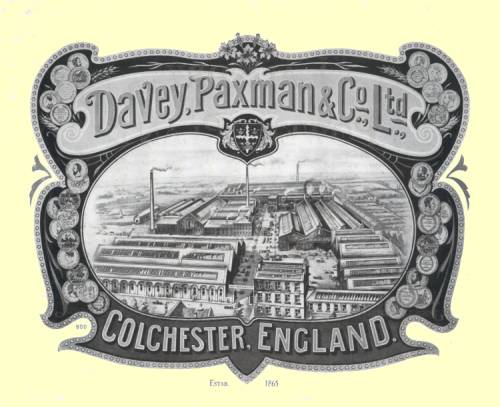Davey, Paxman & Co of Colchester
Some History of a Famous Engineering Company,
its Products and Achievements
Welcome
 This website aims to record some of the history of Davey Paxman & Co of Colchester, England, and to make that history accessible to a wide audience. During an eventful history, spanning 155 years, the company became a world leader in engineering innovation and manufactured a wide range of products. It made a major contribution to the economic and social life of Colchester. Rather than allow the story of the company and its many achievements to be forgotten, I and others who previously worked for Paxman wish to see it preserved for future generations.
This website aims to record some of the history of Davey Paxman & Co of Colchester, England, and to make that history accessible to a wide audience. During an eventful history, spanning 155 years, the company became a world leader in engineering innovation and manufactured a wide range of products. It made a major contribution to the economic and social life of Colchester. Rather than allow the story of the company and its many achievements to be forgotten, I and others who previously worked for Paxman wish to see it preserved for future generations.
Through various 'downsizings' and 'rationalisations' between the late 1980s to 2003 the size of the Company and the scale of its operations progressively diminished. In June 2000 the business was acquired by MAN B&W Diesel AG of Germany. At the end of November 2003 manufacturing was transferred from Standard Works to Stockport, but in mid-2005 MAN B&W decided to cease making the VP185 engine range there and to withdraw it from the market. Due to strong customer interest in the VP185, the Colchester Works resumed building and testing new VP185s in July 2005. In 2012 the company began offering the VP185 with the option of electronic fuel injection (EFI). In 2018 the factory continued to be busy, with a substantial order book for new VP185s.
On July 15th 2020 MAN Energy Solutions announced its proposal to close the Colchester site by the end of that year. Closure did not proceed as quickly as planned but by the end of April 2021 the site was effectively closed with only a handful of people remaining to complete some engine overhaul work and to prepare for final closure. This marked the end of Paxman's 155 year history in Colchester and the end of its 144 years of operation on the Hythe Hill site.
If you are visiting this site for the first time and are unfamiliar with the Paxman story, you may like to start by reading the Introduction to the Company lower down this page.
The history of Paxman can be considered as a story of two parts. The first part, from its founding in 1865 up to the 1920s, is dominated by steam engines and boilers. The second part, from 1925 to the present day, centres around the Company's diesel engine activities. This website attempts to provide extensive coverage of both parts of the story. Paxman has also been involved in other fields, such as filtration, which have not been forgotten in the story told here.
For an overview of Paxman's steam activities the best place to start is the page Paxman and Steam Engineering. To learn about Paxman's work in the design, development and manufacture of diesel engines, I suggest you start by reading, in turn, the pages - Paxman Heavy-Fuel-Oil Engines, Paxman Heavy Duty Diesel Engines, and Paxman Diesel Engines since 1934
If you already know something of Paxman's history and are seeking information on a particular activity or topic you will probably find it most helpful to go to the Site Map and Contents page. Here you will find a listing of each page on this site with a summary of its content as well as a facility for searching the wealth of material now available here.
Richard Carr
Notes for Site Visitors
- Your attention is drawn to the Disclaimer of Liability applying to this websites and its content.
- This is not an official Paxman website and does not claim to carry any official approval or endorsement by the Company. See the Contact page for Company contact details and official websites.
- Using a link from here to a different site will normally open a new window in your browser. After visiting the linked site, close the new window to return to the page you were browsing here.
- TIP: Some pages on this site are lengthy. To find a particular name or word on a page hold down the Ctrl key and press F. Enter the name or word in the search box which will appear and then click on OK. This handy tip should work on any website.
Latest News
(in reverse chronological order - most recent first.)
MAN Energy Solutions becomes Everllence
A press release issued on 4th June 2025 announced that the former business of MAN Energy Solutions was now operating under a new name and had become 'Everllence'. The company's CEO, Uwe Lauber, said: "Our name change is the logical next-step in the execution of our ‘Moving big things to zero’ strategy, which focuses on decarbonization and efficiency solutions . . "
'Everllence remains part of the Volkswagen Group, and the company’s product and service portfolio also remains unchanged'.
According to the press release, the new name of 'Everllence' is a combination that merges the two English-language terms ‘ever’ and ‘excellence’, two central attributes of the company's self-image.
'Ever' expresses over 250 years of company history where the company has written industrial history for as long as industry has existed, but has always looked to the future – to the new and innovative, to the 'first-ever'. From the first diesel engine to the first diesel-powered, ocean-going vessel; from the first wind turbine to the first gas engine and the world's largest fluvial heat pump – the company has always been driven by innovative strength, engineering and a pioneering spirit throughout its long history.
The term 'excellence' refers – on the one hand – to the company's high technological standards as cutting-edge technology is at the heart of the company's DNA. But beyond the technical aspects, Everllence also stands for 'excellent' corporate management at all levels: whether in internal company processes; cooperation with colleagues, partners and customers; leadership culture; or corporate citizenship.
Some of us might question the wisdom of adopting a new name that offers no clues as to the former identity of the business or the nature of its business. No doubt some public relations or marketing consultancy was paid handsomely to come up with the new name, and vast sums will be spent on new branding, stationery and publicity literature, et al. Reminiscent of Aberdeen Asset Management that spent a fortune on changing its name to the unpronounceable 'Abrdn'. Earlier this year it restored the vowels in Aberdeen! (posted 16-06-25)
Paxman Site Clearance
On 31st October (2024) Don Meiklejohn was in Colchester and went past the Paxman site for the first time in over 4 years and took some photographs through the fence. Don reported that the demolition contractors were just finishing off on all the main buildings. There were still a couple of little bits standing but on the main site nothing of much note. The contractors still have to do a fair bit of rubble clearance but obviously the concrete floors are still there as is the basement under the office block. The old Regulateurs Europa building is unoccupied again and out for leasing although the website says they will accept a sale. The water towers and the substation are still there on the other side of the RE building but Don suspects they may still be required to supply it. They also do not appear to have touched The House on the Hill yet. Notices on the fence would indicate that MAN still own the main site. (posted 02-11-24)
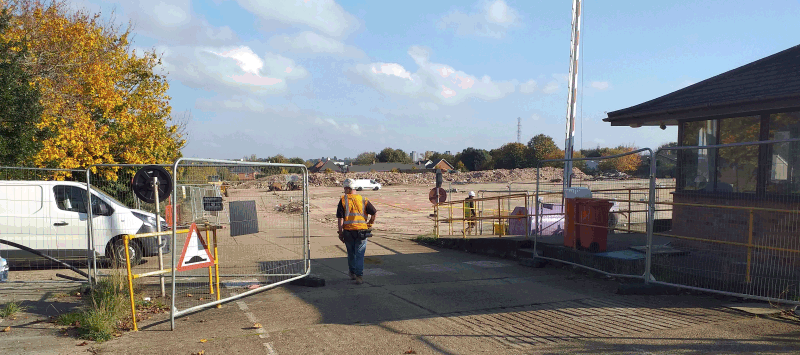
The former Paxman site as at 31st October 2024 viewed through the former Harsnett Road Gate in Port Lane.
Photo © Don Meiklejohn 2024
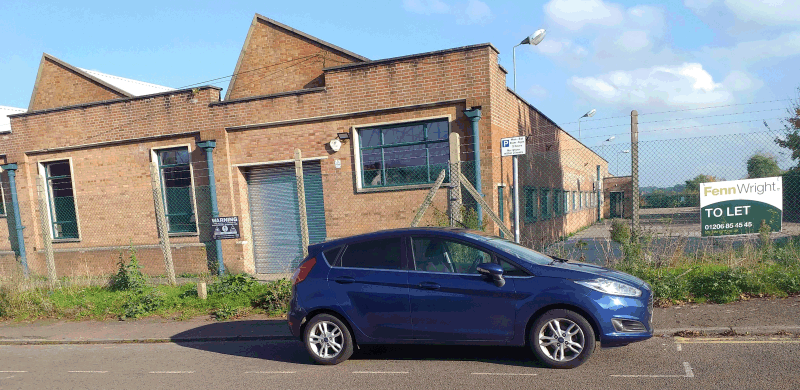
The former Regulateurs Europa building viewed from Port Lane on 31st October 2024. 'To Let' through Fenn Wright.
Photo © Don Meiklejohn 2024.
Demolition of Main Office Block and South Shop
As at early October this year, demolition of the old Main Office block in Port Lane, and the South Shop behind it, is well under way. Apparently the engine test cells are still standing - for now. Having spent fifteen years of my career working in the Main Office block, during which I very frequently popped into the South Shop, it will feel strange to drive along Port Lane now and find these old haunts are no more.
The Main Office block was built in 1954-55. It used to house the Directors' offices (on the first floor; nicknamed 'the flight deck'), the Diesel Engine Design and Applications Engineering Offices, the Personnel and Finance Departments, Purchasing, and Business Systems.
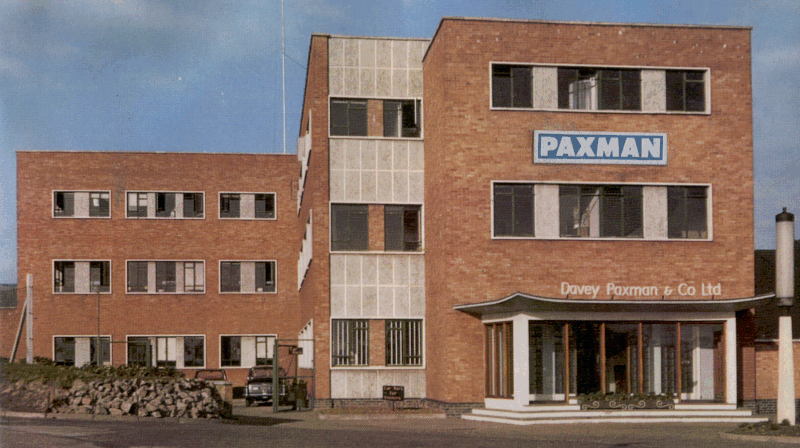
Paxman's Main Office block in the mid-1960s.
The original section of the South Shop was well established by 1965. In the 1970s the building was greatly extended and the enclosed engine test cells were added. These extensions cost £3 million and the enlarged facility was opened formally in August 1975. (posted 06-10-24)
Nigel Ramsden (1933-2022): Many will be saddened to learn that Nigel Ramsden died on 11th June last year (2022), at the age of 88. It is only recently we have learnt of his death and we offer our condolences to his widow, Barbara.
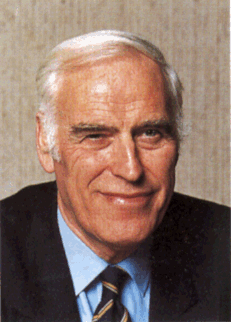 Nigel was appointed Technical Director of Paxman in May 1984 and continued in that role until his retirement in May 1998.
Nigel was appointed Technical Director of Paxman in May 1984 and continued in that role until his retirement in May 1998.
His early engineering career was in aerospace and he was a Member of the Royal Aeronautical Society (MRAeS). Ian Drake recalls Nigel telling him at some length about the flutter characteristics of the wing on the Blackburn Buccaneer. The Buccaneer was designed and initially built at Brough (near Hull in East Yorkshire). Ian remembers Nigel mentioning Brough.
Nigel joined GEC in April 1962. Prior to coming to Paxman, he had worked at GEC's Structural Engineering Laboratory, near Leicester, and then at GEC's Engineering Research Centre at Whetstone.
Nigel was asked to come to Colchester to investigate and resolve problems with the 12RP200L (Valenta) engines installed in the power cars of the HST (High Speed Train, also known as the InterCity 125). At the time GEC was under considerable criticism from British Rail. Constant engine failures were having a major impact on the HST's reliability and availability. To be fair, not all the problems were down to Paxman. Some were due to BR's lack of proper maintenance and its use of the HST on services with frequent stops and starts, for which the engine was not designed. The defects caused by thermal cycling became acute in the long hot summer of 1983. Nigel's team of development engineers carried out a great deal of careful investigation into the matter and subsequent changes to the engine's design overcame the problems. It could be argued that Nigel and his colleagues were too successful in improving the design of the Valenta. The engine became so reliable that Paxman's sales of spares, one of the company's most profitable activities, suffered a decline.
Nigel was awarded the Nelson Gold Medal in 1988 for outstanding contribution to Engineering in GEC.
Nigel's greatest achievement at Paxman was, I believe, leading the design and development of the world-class VP185 engine. In the mid-1980s GEC Diesels was contemplating the idea of a new basic engine design to be shared between Ruston and Paxman. The intentions were that it should have a standard bore size and many common components, with Ruston developing the medium speed version and Paxman the high speed one. Nigel argued strongly that this was not a practical proposition because of unique factors relating to high speed engine design. He successfully persuaded Dr Harvey Perkins, then Group Managing Director of GEC Diesels, that Paxman needed to develop its own next generation engine. In November 1987 he presented to the PMC (Paxman Management Committee) his formal proposal for a new engine; a proposal that was accepted with very little debate.
It was a completely new design, not a development of the Valenta which itself had been a development of the Ventura. Nigel started with what was effectively a clean sheet of paper. Elements of his design were so revolutionary that some of the company's most knowledgeable and experienced engineers had serious doubts about whether the design was practical with the technology and materials then available. Without Nigel's ideas, his enormous drive and energy, his forceful personality and absolute commitment one wonders whether the new engine would ever have seen the light of day. The result was an engine that thirty years after its launch in 1993 continues to be highly regarded by users around the world. The design and development of the engine at Colchester, under Nigel's direction, was a tremendous achievement.
Nigel led the Paxman team in its application for the 1998 MacRobert Award, with a submission about the VP185 range of high performance diesel engines. The team was a finalist in the competition for our country's most prestigious award for engineering innovation.
Malcolm Frost, Personnel Manager during Nigel's time with the company, comments: "I got on with Nigel very well. We had many a discussion about 'Performance Engines' after hours. A great engineer and also a lovely human being". A warm human note on which to end this tribute to Nigel.
My grateful thanks to Will Pavry, Ian Drake and John Benham for providing information and checking my draft of the above. (posted 07-09-23)
Paxman Gas Engine in Normandy
A long time ago (the now late) Alex Walford visited and photographed an old Paxman gas engine in Normandy, when it was in working order. As at December 2010, the engine was reported to be at the Musée des Fours à Chaux de Regnéville (Lime Kilns Museum) at Regnéville-sur-Mer, a small village on the coast of Normandy, west of Saint-Lô, near Coutances. Various enquiries were then made by myself and others to see if anyone could tell us exactly where the engine was now located and find out its number, but without success - until now.
On 23rd September (2021) I was delighted to receive an email from Philippe Castel, a French engine enthusiast, who, with the help of the museum's curator, had been to see the engine the previous day. The engine is not on public display but is currently stored in the museum's reserve collection. Philippe and the curator successfully located the engine's number stamp. The stamped number is 18500. Being advised of this I was able to look up details of the order in a surviving Paxman copy order book. Information about the engine and its history has now been updated on the Paxman Gas Engines page. (post updated 04 Oct 2021)
Last VP185 Leaves Colchester
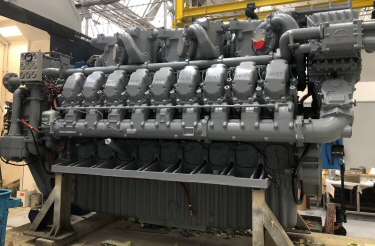 The very last VP185 engine to be built at the Colchester works was dispatched on Thursday 26th November, by road to a shipyard in Turkey. The 18-cylinder engine (pictured right), an 18VP185TCM, is the last of four that are to be installed in an offshore patrol vessel (OPV).
The very last VP185 engine to be built at the Colchester works was dispatched on Thursday 26th November, by road to a shipyard in Turkey. The 18-cylinder engine (pictured right), an 18VP185TCM, is the last of four that are to be installed in an offshore patrol vessel (OPV).
Photo © and courtesy of MAN Energy Solutions
This marks the end of new engine build on a site the Paxman business has occupied since 1876.
There is other engine work to be completed on the site before its closure sometime in the early part of 2021. (post updated 20-12-20)
MAN Confirms Closure of Colchester Site
On 5th November MAN Energy Solutions issued a press release confirming closure of the Colchester site. According to the press release the decision to close the site "was taken after consultations with employee representatives failed to produce any alternative scenario for a viable business at the site."
Up to 80 employees will be affected by the closure. As yet we don't know the intended date of closure.
The press release can be viewed and/or downloaded using this link: MAN Energy Solutions Confirms Closure of Colchester Site (posted 06-11-20)
MAN Energy Solutions Publishes Paper about Restructuring
The executive board and employee representatives of MAN Energy Solutions have agreed on a joint paper outlining the key points of the restructuring of the business. The paper proposes a reduction of approximately 2,600 jobs, around 1,650 in Germany and 950 in other European and non-European countries. Subject to certain targets being met, Volkswagen will suspend its plans to sell MAN Energy Solutions until the finalization of the restructuring efforts. This will apply at least until the end of 2024. Volkswagen Group has further agreed that the company will remain part of the group until at least the end of 2026 if it achieves a set profitability target by that date.
The paper cast more light on the background to the proposed closure (reported in the news item below) of the Colchester site by the end of December this year. It also provides an insight into VW Group's requirements and expectations regarding the restructuring.
A press release issued on Monday, 3rd August, about the restructuring paper, can be viewed and/or downloaded using this link: Restructuring Press Release (posted 05-08-20)
Proposed Closure of the Colchester Site
On Wednesday, 15th July, MAN Energy Solutions announced that it proposed closing the Hythe Hill, Colchester, site by the end of December this year (2020). The closure could affect up to 80 people currently employed at the Colchester business unit.
If the closure goes ahead as planned, it will, very sadly, mark the end of Paxman's 155 year history in Colchester and the end of its 144 years of operation on the Hythe Hill site.
Articles about the proposed closure were published in the local press, such as the Essex County Standard (on Friday, 17th July) and its sister papers.
Jan Zebitz, UK Managing Director of MAN Energy Solutions, is quoted in the local press as saying: "It is clear that the global crisis has had, and continues to have, a major impact on our business" and "The shipping industry has been heavily affected, while the market situation for the engine type we build in Colchester was already difficult even before the pandemic's arrival" and "We simply lack the order volume necessary to carry on, and, therefore we must review production at Colchester." The firm plans to concentrate its UK operations in Stockport.
MAN issued a press release on Wednesday, 22nd July, which can be viewed and/or downloaded using this link: MAN Energy Solutions Launches Program for the Future . It is clear from this announcement that the planned closure of the Colchester site is part of a much bigger plan for the business. The executive board of MAN Energy Solutions expects that the implementation of its 'Program for the Future' will result in the elimination of up to 3,000 positions in Germany and 950 abroad. (post updated 24-07-20)
Paxman 8VPE Engine at Lismore, NSW: The only VP/VPE ever made and the largest of Paxman’s ‘Heavy Fuel Oil Engines’ ever built, No 23912, was ordered in December 1931. Components for it were despatched from Colchester in at least three batches during April 1932. The engine was installed for power generation in the Lismore Power Station in New South Wales. This truly unique and very large engine has survived and is still where it was originally installed.
A recent photograph shows it to be in far better condition than in some older photographs I have. A local group is working towards the preservation of the former power station and its engines and is trying to acquire the building from the NSW state power company (Northern Rivers Electricity?) that owns it. The group is currently trying to get one of the other engines (a GM 16-567B, 1440 bhp at 750 rpm) going and then hoping to get the Paxman 8VPE back into running order by mid-2020. (posted 07-09-19)
Update on the Colchester Business: In February 2003 MAN announced that production of the VP185 engine was to be transferred from Colchester to the Mirrlees Blackstone factory at Stockport. In September that year what was expected to be the last new VP185 to be built at Colchester was despatched from the factory. The Colchester business was subsequently confined to fulfilling a customer support role, dealing with spares, service and engine repairs and overhauls. Some time later, even the spares and service functions were transferred to Stockport.
The Stockport factory, which had previously specialised in building large medium-speed diesels, struggled with manufacture of the high-speed VP185. Consequently MAN decided to withdraw the engine from the market and to cease its production.
Despite this train of events, customer interest in, and demand for, the VP185 remained strong. As a result, in late July 2005, assembly and test of new-build VP185s recommenced at Colchester. Although the engine was no longer officially promoted or marketed by the company, orders for it continued to flow in. These included the large Taiwan contract for sixty 12-cylinder types and numerous orders for 18-cylinder types for Vietnam. All assembly and test for these engines has been, and continues to be, undertaken at Colchester. However, until now, Colchester’s official role has been the repair and overhaul of Paxman and other MAN engines, not new engine build.
Recently there has been a major change of policy. Last year MAN decided to restore the VP185 to its engine portfolio. The engine is being offered for rail traction and gen-set applications as well as marine propulsion. The Colchester plant is now an official engine production site again. MAN is investing £1.5 million at Colchester to upgrade its facilities for new-engine assembly and test. The upgraded facility is scheduled to be up and running by the end of March this year and engine production volumes are planned to increase dramatically. The engine sales team is being increased and additional assembly staff are being recruited.
This is all most encouraging for those working at the Colchester Business Unit and for those of us who previously worked for Paxman and retain an interest in the business. (posted 17-01-18)
Call for RW Engine Cylinder Heads: This request was originally posted here in 2012 but as at late 2015 there had not been any positive response. In December I received a further email from Norway asking if anyone could help with sourcing some RW cylinder heads.
In 1938 Paxman supplied an 8-cylinder RW engine to Norway for installation in a small fire-fighting vessel. The vessel, Slukk II (Extinguish 2), was built by Nyland Mek of Oslo for Kristiansund's Fire Department and was in service from 1939 to 1986. It is now in preservation at Kristiansund and the small group which looks after it needs replacement cylinder heads. Due to corrosion the cast-iron of the originals is now very thin and three of the four heads (which are cast in pairs) have cracks in them. Trying to source heads for the RW is, understandably, a real problem. If you think you can help, perhaps by pointing us to a possible source, please do contact me. (posted 19-05-12 and update posted 03-01-16)
£39million Engine Order for Colchester: Now it is in the public domain *, I am at liberty to disclose the fact that MAN Diesel & Turbo UK last year secured a £39million contract for VP185 engines which will be built at the former Paxman Works at Colchester. The order is for sixty 12-cylinder VP185 engines, each rated 3,640 bhp, for installation in 28 fast patrol boats for the Taiwanese coastguard service. The boats, each with two engines (four engines are spares), are being built by the Ching Fu Shipbuilding Company of Taiwan.
The engines will be supplied over a six-year period with the first two having already been delivered. As a result of the contract, the company has hired six additional fitters and two new apprentices at Colchester. It is encouraging to know the factory now a good baseload of work for the next few years. (posted 03-05-14)
* East Anglian Daily Times article, 2nd May 2014.
Major VP185 Order Received: MAN Diesel & Turbo UK's Colchester Business Unit received an order for eighteen 18-cylinder VP185TCM engines in January 2012. The engines are for the Vietnamese Marine Police and the Vietnamese Navy which, between them, already have eighteen 18VP185 engines in service. Those engines on order are for the main propulsion of six triple-engine, triple-screw fast patrol boats. Port and starboard engines are identical, with the flywheel facing aft and coupled to a reverse-reduction gearbox driving a propeller shaft. The centre engine's flywheel faces forwards, and is coupled to a U-drive, reverse-reduction gearbox connected to a propeller shaft which runs back underneath the engine. Each engine is rated at 4MW at 1,950 rpm. The new engines are to be compliant to IMO Marpol Annex VI, Tier II on exhaust emissions.
The engines on order will be designated 18VP185TCM. This is a change from the notation previously used for identifying Paxman engine types, and has been introduced in order to clarify different engine builds with the Classification Societies. The 'T' suffix denotes the engine is fitted with Triple turbo boxes, the 'C' suffix denotes that the engine is Conventionally fuel injected, and the 'M' suffix denotes that the engine is for Marine propulsion application.
The order is a very welcome boost for the Colchester Business Unit and further evidence of the high regard in which the Paxman-designed VP185 is held. (posted 27-01-12)
August 2008 Update: The 'Two Box' Paxman 12VP185 spare engine ordered by Tenix for the Royal New Zealand Navy, and built at Colchester, was despatched on August 4th or 5th. Other interesting engine order prospects are in the pipeline but for obvious reasons cannot be disclosed at this stage. Reorganisation of the South Shop continues, to create additional space to accommodate the workload. As at mid-August relocation of the Fabrication facilities in the South Shop is imminent.
Engines in Build at Colchester : It is good to learn that as at early January 2008 Paxman's Colchester factory is busy. In build are three 18VP185 engines for the Vietnam Marine Police, the first of which has just gone to the test bed. The order for these engines was signed last summer (2007). This was a follow on from the six VP185s already delivered to this customer, three of which were built at Colchester. The engines, three per vessel, are for main propulsion of three fast patrol craft.
An order has also been received for a spare 'Two Box' 12VP185 from Tenix which is building four Inshore Patrol Vessels at its Whangarei yard for the Royal New Zealand Navy. Each RNZN vessel has two 'Two Box' 12VP185 engines for main propulsion, some of which were built at Colchester.
Because of the shortage of space arising from the Colchester factory's large workload, plans were announced during the summer of 2007 to move Paxman's spares stores to the Mirrlees factory at Stockport.
Introduction to the Company
The business of Paxman in Colchester, Essex, has a long and proud history of engineering excellence and innovation. It earned a world-wide reputation for its large high speed diesel engines and was a major influence on the social and economic life of Colchester from the late nineteenth century up to the late 20th century. During the 1960s the Company employed as many as 2,500 people. Although the number of employees progressively diminished in succeeding decades, Paxman remained a major engineering employer in the area until 2003.
The Company was founded in 1865 by James Noah Paxman, in partnership with two brothers Henry and Charles Davey, trading as 'Davey, Paxman & Davey, Engineers'. In its 155 year history the name and ownership of the business underwent various changes which are described on the page tracing the course of Paxman's ownership and corporate identity.
The original Standard Ironworks was a brick and timber building situated more or less where Waterstones Bookshop now stands in the Culver Precinct area of the town. The business expanded rapidly in the years after it was formed and soon needed more space. James Paxman acquired the site of an old brickworks on Hythe Hill to which the Company moved in 1876 and where it was based until its closure in early 2021. The site had previously been a brickyard. The astute and enterprising Mr Paxman re-opened the brickyard to produce all the bricks for building his new Works. After the factory was completed the brickyard plant was dismantled and the space used for later extensions. The new site was also called Standard Ironworks and at this stage covered an area of 11 acres. The Works expanded and for very many years, up to 2003, occupied approximately 23 acres.
From 1941/42 the Company also occupied Britannia Works adjacent to Colchester Town railway station. 'The Brit' as it came to be known was originally leased by the Ministry of Supply to provide Paxman with space for building their TP engines during the Second World War. Later it housed the Development Department for many years and some machining facilities prior to closure in 1982. It was demolished in 1987 to create a car park. At the bottom of St Botolph's Street a Paxman engine crankshaft now stands on a plinth to mark the site of the former Works.
Davey, Paxman & Davey commenced business as general engineers offering their services to farmers, millers, builders, and other machinery users in the locality. In addition to iron and brass foundry work they manufactured and repaired steam engines, boilers, agricultural machinery, and mill gearing. James Paxman had previous experience of building steam engines and the new firm soon became highly successful in this field. The Company's first steam engine appeared by 1870 and received a very favourable press. 'The Engineer' said of the boiler "We have no hesitation in pronouncing it the best vertical boiler yet produced". The plant was the most economical of those tested at the Royal Agricultural Show that year. The immediate success of the Company's first stationary vertical engines and boilers encouraged it to increase its range of horizontal stationary and portable engines. For more details see the page on the history of Paxman and steam engineering.
James Paxman was not slow to exploit opportunities in overseas markets. By the early 1870s he was exporting machinery to the Kimberley Diamond Mines in South Africa. For thirty years (between 1880 and 1910) he travelled and exhibited extensively overseas to promote his Company's products. Throughout its subsequent history the Company has continued to be very active in export markets.
The next important development was oil and gas engines, the first being built in 1904. These were horizontal, open-crank designs. Paxman's earliest oil engines ran on 'light spirits' and had low-tension magneto ignition. The gas engines sold much more successfully than the very similar oil engines, and many of these were sold to overseas customers. More about these engines and their features appear on the pages Paxman Benzine Engines and Paxman Gas Engines. Compression ignition oil engines were to follow but their development was delayed by the demands of war production between 1914 and 1918. Paxman built prototypes of its vertical 'spring injection' oil engine in 1925 before publicly launching it in 1927. The history of these engines, which found a ready market in electrical power generation applications, is to be found on the page Heavy-Fuel-Oil Engines. The second generation of the Company's oil engines, the Heavy Duty Diesel appeared on the market in early 1931.
From the 1930s the Company's main activity became the design and manufacture of diesel engines. After 1934 these were medium or high speed diesels, built to meet the needs of customers requiring a high power to weight ratio. In short, a relatively light, compact engine with a high power output. That being said many of the engines produced in recent years weigh in the region of seven to ten tons with power outputs of up to 5,500 bhp. For details see Paxman engines since 1934.
All these engines were designed, developed, and manufactured at Colchester. The machining of major components (e.g. crankcases, con rods, cylinder heads and cylinder liners) and many smaller parts, building, testing and overhauling engines were all undertaken at Standard Works until early 2003. It should be added that up until 1979 the Company had its own large foundry on the Standard Works site and a pattern shop. On 13th September 1979 the foundry produced its last casting, a 12YJ engine crankcase.
An important factor in the Company's success was its strength in the field of applications engineering, working closely with customers to tailor engines to their highly specific requirements. Paxman engines are used in applications as diverse as marine main propulsion in fast naval patrol craft and fast ferries, specialist power generating sets where size and weight are critical, and rail traction as in the British High Speed Train (the HST, popularly known as the Intercity 125) and its Australian equivalent. There is a page on this website illustrating a variety of applications of the most recent engine ranges.
Markets were world wide with engines giving service in North and South America, the Gulf States, Africa, Pakistan, the Far East, Australia, and many other locations not forgetting the UK and Europe.
Paxman became part of MAN B&W Diesel Ltd in June 2000. On 18th May 2001 MAN announced a re-organisation of its diesel engine businesses in the UK. At that stage management of the Paxman engine business was transferred to MAN B&W Diesel Ltd's Strategic Business Unit - High Speed, based at Stockport in Cheshire. The implications for Paxman became more visible in Spring 2002 when most of the Sales, Contracts, and Finance functions were transferred from Colchester to Stockport. During 2002 instructions were issued to remove the Paxman name from most brochures and other literature and to replace it with the MAN B&W Diesel Ltd identity. It was sad to see the name of a business, known and respected throughout the world, being systematically erased. By the end of December 2002 the Development function had been disbanded and the Engineering (design) function reduced to a small handful of people to support existing engines. Never again will a new Paxman engine be designed at Colchester.
On Thursday 6th February 2003 MAN B&W Diesel Ltd announced in a press release its proposals to transfer manufacture of the flagship Paxman VP185 engine to Stockport. The transfer progressed relatively rapidly. The last production (i.e. not overhaul) VP185 engine to be built at Colchester was despatched from the Works on Monday 15th September 2003 to a railway customer. Manufacture of components finally ceased at Colchester at the end of November 2003 when the few remaining machine shop staff were dismissed. Those machine tools and other items of plant not required at Stockport or for the overhaul facility were auctioned off the following week, on 2nd December. This looked like the end of 138 years of manufacturing by Paxman at Colchester. All that was left on the Standard Works site was the Diesel Service (Spares, Service and Overhaul) activities, employing around 100 people, and Regulateurs Europa. The latter was sold to the Heinzmann Group in December 2005.
The Stockport factory was unable to manufacture the VP185 successfully and made a substantial loss on each one they built. This led to a decision to cease manufacture and to dispose of the machining facilities which had been transferred from Colchester. However, so strong was customer interest in the engine that the issue was reviewed. In July 2005 the Paxman factory at Colchester resumed the build and test of new VP185s. Development work on the engine continued and in 2012 the Company started to offer versions of the VP185 with Electronic Fuel Injection (EFI). In 2017 MAN restored the VP185 to its engine portfolio, offering it for rail traction and gen-set applications as well as marine propulsion. The Colchester plant became an official engine production site again.
On July 15th 2020 MAN Energy Solutions, the owner of the former Paxman business, announced its proposal to close the Colchester site by the end of that year. The following January local newspapers reported that MAN had confirmed the Paxman factory would close at the end of March or in mid-April, once final orders had been completed on site. A sad end to Paxman's 155 year history in Colchester and its 144 years of operation on the Standard Works site off Hythe Hill.
Your input - Please contact me if you have additional material for submission or would like to offer any comments or suggestions. From time to time new pages are added to the site, and existing pages are updated as new information becomes available.
Web hosting provided by Paul Evans and the Internal Fire Museum of Power, whose support is gratefully acknowledged.
Page updated: 16 Jun 2025 at 16:42

